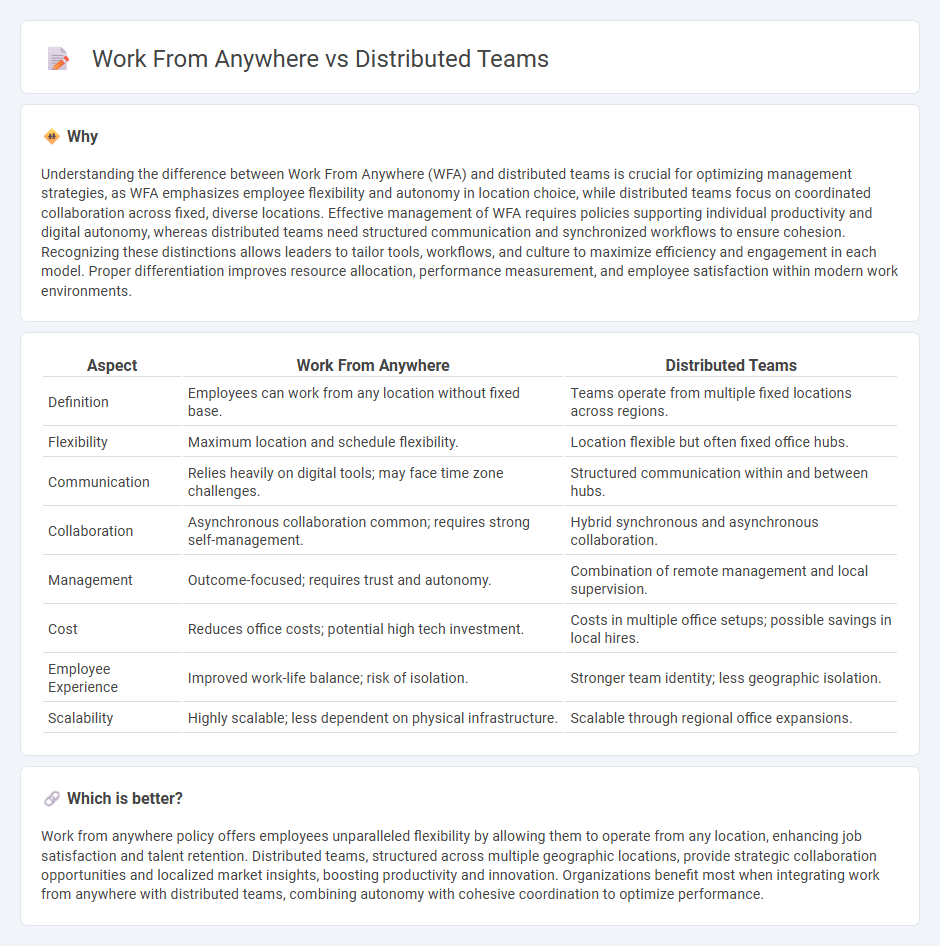
Work from anywhere policies empower employees to operate from any location, enhancing flexibility and attracting a diverse talent pool. Distributed teams, structured across different geographical regions, leverage time zone advantages and localized expertise to boost productivity and innovation. Discover how balancing these approaches can transform your organizational management strategies.
Why it is important
Understanding the difference between Work From Anywhere (WFA) and distributed teams is crucial for optimizing management strategies, as WFA emphasizes employee flexibility and autonomy in location choice, while distributed teams focus on coordinated collaboration across fixed, diverse locations. Effective management of WFA requires policies supporting individual productivity and digital autonomy, whereas distributed teams need structured communication and synchronized workflows to ensure cohesion. Recognizing these distinctions allows leaders to tailor tools, workflows, and culture to maximize efficiency and engagement in each model. Proper differentiation improves resource allocation, performance measurement, and employee satisfaction within modern work environments.
Comparison Table
| Aspect | Work From Anywhere | Distributed Teams |
|---|---|---|
| Definition | Employees can work from any location without fixed base. | Teams operate from multiple fixed locations across regions. |
| Flexibility | Maximum location and schedule flexibility. | Location flexible but often fixed office hubs. |
| Communication | Relies heavily on digital tools; may face time zone challenges. | Structured communication within and between hubs. |
| Collaboration | Asynchronous collaboration common; requires strong self-management. | Hybrid synchronous and asynchronous collaboration. |
| Management | Outcome-focused; requires trust and autonomy. | Combination of remote management and local supervision. |
| Cost | Reduces office costs; potential high tech investment. | Costs in multiple office setups; possible savings in local hires. |
| Employee Experience | Improved work-life balance; risk of isolation. | Stronger team identity; less geographic isolation. |
| Scalability | Highly scalable; less dependent on physical infrastructure. | Scalable through regional office expansions. |
Which is better?
Work from anywhere policy offers employees unparalleled flexibility by allowing them to operate from any location, enhancing job satisfaction and talent retention. Distributed teams, structured across multiple geographic locations, provide strategic collaboration opportunities and localized market insights, boosting productivity and innovation. Organizations benefit most when integrating work from anywhere with distributed teams, combining autonomy with cohesive coordination to optimize performance.
Connection
Work from anywhere policies rely on distributed teams to enhance flexibility, productivity, and access to global talent pools. Effective management of distributed teams requires robust communication tools, clear goal-setting, and trust-building strategies to overcome challenges like time zone differences and cultural diverse. Emphasizing asynchronous collaboration and outcome-based performance metrics ensures seamless coordination and sustained team engagement in a remote work environment.
Key Terms
Remote Collaboration
Distributed teams leverage geographically dispersed members connected through digital tools to enhance productivity and innovation in remote collaboration. Work from anywhere models prioritize flexibility, allowing individuals to choose their work location while maintaining seamless communication via cloud-based platforms. Explore the key strategies and technologies that optimize remote collaboration for both approaches.
Asynchronous Communication
Distributed teams rely heavily on asynchronous communication tools like Slack, Trello, and email to coordinate projects across different time zones efficiently. Work from anywhere policies encourage employees to choose flexible locations, making asynchronous communication essential for maintaining productivity without real-time dependency. Explore best practices and tools to optimize asynchronous communication and enhance collaboration in diverse work environments.
Results-Based Performance
Distributed teams enable organizations to leverage diverse talent across multiple locations while emphasizing asynchronous communication and goal-oriented workflows to drive productivity. Work from anywhere policies expand employee flexibility, promoting autonomy and job satisfaction by allowing individuals to choose their optimal work environment, which can boost overall results-based performance. Discover how integrating these strategies can transform your organization's approach to achieving measurable outcomes.
Source and External Links
Distributed vs Remote Teams: A Guide for Businesses - Aircall - Distributed teams consist of members working in separate geographical locations, often with no main headquarters, connected virtually using cloud-based tools, allowing companies to hire talent regardless of location and coordinate effectively across distances.
A Distributed Team Guide - Everything You Need to Know About ... - A distributed team is defined by employees working from different cities or countries without needing to share the same physical workspace, relying on digital infrastructures like cloud phone systems and video calls to maintain collaboration and communication.
7 Tips To Help Manage Your Distributed Team [2025] - Asana - Managing distributed teams involves coordinating members across locations and time zones using clear communication, consistent meetings, and respect for boundaries to maximize the benefits and handle challenges inherent in geographic dispersion.
 dowidth.com
dowidth.com